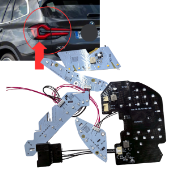-
Welcome to Auto Parts Forum
Whether you are a veteran automotive parts guru or just someone looking for some quick auto parts advice, register today and start a new topic in our forum. Registration is free and you can even sign up with social network platforms such as Facebook, X, and LinkedIn.
Continental Introduces LED Driving Lights for Off-Highway Use
-
Similar Topics
-
By GreenGears Auto Limited
The automotive industry is undergoing a profound transformation, driven by the synergistic forces of connectivity and autonomous driving. These technological advancements are poised to reshape the transportation landscape, promising safer, more efficient, and more accessible mobility solutions for individuals and societies alike.
Connectivity, the ability of vehicles to communicate with each other and their surroundings, is laying the foundation for intelligent transportation systems that can revolutionize the way we navigate our roads. Autonomous driving, on the other hand, envisions a future where vehicles can operate without human intervention, offering the potential for unprecedented levels of safety and convenience.
This in-depth exploration delves into the complexities of connectivity and autonomous driving, examining their underlying technologies, current progress, challenges, and the transformative impact they are expected to have on our world.
The Evolution of Connectivity: From Isolated Vehicles to Interconnected Networks
Historically, vehicles have been isolated entities on the road, relying solely on the driver's perception and decision-making. However, the advent of connectivity has transformed cars into sophisticated communication hubs, capable of gathering and exchanging vast amounts of data in real-time.
This transformation has been made possible by a convergence of technological advancements, including:
Sensor Technology: Vehicles are now equipped with a wide range of sensors, including cameras, radars, lidars, and ultrasonic sensors, that enable them to perceive their surroundings in detail. These sensors collect data about the vehicle's position, speed, proximity to other objects, and road conditions. Wireless Communication: Technologies like Dedicated Short-Range Communications (DSRC) and Cellular Vehicle-to-Everything (C-V2X) allow vehicles to communicate wirelessly with each other and with infrastructure elements like traffic lights and road signs. Cloud Computing and Data Analytics: The vast amounts of data generated by connected vehicles are processed and analyzed in the cloud, enabling real-time decision-making and the development of intelligent transportation systems. Types of Connectivity:
Connectivity in the automotive realm manifests in various forms, each with its own distinct benefits:
Vehicle-to-Vehicle (V2V) Communication: Enables direct communication between vehicles, allowing them to share information about their speed, location, and intended maneuvers. This creates a virtual awareness network, enhancing safety by alerting drivers to potential hazards and enabling cooperative driving behaviors.
Vehicle-to-Infrastructure (V2I) Communication: Facilitates communication between vehicles and roadside infrastructure, such as traffic lights, road signs, and toll booths. This allows for optimized traffic flow, reduced congestion, and improved safety through real-time information sharing.
Vehicle-to-Network (V2N) Communication: Connects vehicles to cloud-based services and applications, providing access to real-time traffic updates, navigation assistance, and other infotainment features.
Vehicle-to-Pedestrian (V2P) Communication: Enables vehicles to communicate with pedestrians and cyclists, particularly in urban environments. This can enhance safety for vulnerable road users by alerting them to the presence of vehicles and potential dangers.
Benefits of Connectivity:
The widespread adoption of connectivity has the potential to unlock numerous benefits for individuals, society, and the environment:
Enhanced Safety: By facilitating real-time data exchange and situational awareness, connectivity can help prevent accidents and reduce fatalities on the roads. Features like collision avoidance systems, lane departure warnings, and blind spot monitoring leverage connectivity to provide drivers with timely alerts and assistance.
Improved Traffic Flow: Connectivity enables intelligent transportation systems to optimize traffic flow by adjusting signal timings, providing real-time traffic information, and recommending alternative routes. This can lead to reduced congestion, shorter travel times, and improved fuel efficiency.
Enhanced Convenience and Comfort: Connected vehicles offer a plethora of features that enhance the driving experience, including:
Remote vehicle access and control In-car entertainment and infotainment systems Personalized navigation and route optimization Real-time vehicle diagnostics and maintenance alerts Over-the-air software updates Environmental Sustainability: By optimizing traffic flow and promoting fuel-efficient driving behaviors, connectivity can contribute to reducing greenhouse gas emissions and improving air quality.
The Path to Autonomous Driving: From Assisted to Fully Autonomous
Autonomous driving, often referred to as self-driving technology, aims to automate the driving experience entirely, freeing drivers from the need to control the vehicle. This technology is being developed in stages, with increasing levels of autonomy, as defined by the Society of Automotive Engineers (SAE):
Levels of Autonomous Driving
Level Description 0 No automation. The driver is fully in control of the vehicle at all times. 1 Driver assistance. The vehicle provides limited assistance with tasks such as steering or accelerating, but the driver remains primarily in control. 2 Partial automation. The vehicle can control both steering and acceleration/deceleration under certain conditions, but the driver must remain alert and ready to take control at any time. 3 Conditional automation. The vehicle can perform all driving tasks under specific conditions, but the driver may still need to intervene in certain situations. 4 High automation. The vehicle can perform all driving tasks under most conditions, and the driver may be able to disengage completely. 5 Full automation. The vehicle can perform all driving tasks under all conditions, and there is no need for a human driver. Key Technologies Enabling Autonomous Driving
The development of autonomous vehicles relies on a complex interplay of various technologies:
Sensor Fusion: Combines data from multiple sensors like cameras, radars, and lidars to create a comprehensive and accurate picture of the vehicle's surroundings. Artificial Intelligence (AI) and Machine Learning: Enables the vehicle to perceive, interpret, and respond to its environment in real-time, making decisions based on complex algorithms and learned patterns. High-Definition Mapping: Provides detailed maps of the environment, including road layouts, lane markings, traffic signs, and other relevant information. Vehicle Control Systems: Actuators and control systems enable the vehicle to execute commands from the autonomous driving system, such as steering, accelerating, braking, and changing lanes. Current State of Autonomous Driving
While fully autonomous vehicles (Level 5) remain a long-term goal, significant progress has been made in developing and deploying lower levels of autonomy.
Advanced Driver-Assistance Systems (ADAS): Features like adaptive cruise control, lane keeping assist, and automatic emergency braking 1 are becoming increasingly common in new vehicles, representing Level 1 and Level 2 autonomy. Robotaxis and Autonomous Shuttles: Several companies are testing and deploying autonomous vehicles in controlled environments, such as designated areas within cities or university campuses. These vehicles often operate at Level 4 autonomy, with limited human supervision. Commercial Applications: Autonomous trucks and delivery vehicles are being developed and tested for logistics and transportation applications, offering the potential for increased efficiency and reduced costs. Challenges and Concerns
Despite the significant progress, several challenges and concerns remain on the road to fully autonomous driving:
Technological Limitations: Current sensor technologies and AI algorithms still struggle to handle complex and unpredictable scenarios, such as adverse weather conditions, construction zones, or interactions with pedestrians and cyclists. Safety and Liability: Ensuring the safety of autonomous vehicles and determining liability in the event of accidents are critical concerns that need to be addressed through robust testing, validation, and regulatory frameworks. Public Acceptance: Gaining public trust and acceptance of autonomous vehicles will require addressing concerns about safety, job displacement, and the potential for misuse of the technology. Infrastructure: Widespread adoption of autonomous vehicles will necessitate significant investments in infrastructure, including intelligent transportation systems, high-definition maps, and communication networks. The Transformative Impact of Connectivity and Autonomous Driving
The convergence of connectivity and autonomous driving has the potential to revolutionize the transportation sector and society as a whole:
Improved Safety: By eliminating human error, which is a leading cause of accidents, autonomous vehicles have the potential to significantly reduce fatalities and injuries on the roads. Studies suggest that autonomous vehicles could reduce traffic fatalities by up to 90%.
Increased Efficiency: Connected and autonomous vehicles can optimize traffic flow, reduce congestion, and improve fuel efficiency. This can lead to significant time and cost savings for individuals and businesses, as well as a reduction in greenhouse gas emissions.
Enhanced Accessibility: Autonomous vehicles can provide mobility solutions for individuals who are unable to drive, such as the elderly or those with disabilities, enhancing their independence and quality of life.
New Business Models: The advent of autonomous vehicles could give rise to new business models and services, such as ride-hailing, car-sharing, and delivery fleets. These models could transform the way we think about transportation, making it more accessible and affordable for everyone.
Urban Transformation: Autonomous vehicles could lead to a redesign of urban spaces, with less need for parking lots and potentially more space for green areas and pedestrian zones.
The Road Ahead: Navigating the Challenges and Opportunities
The path to a fully connected and autonomous transportation future is filled with both challenges and opportunities. As technology continues to advance and regulatory frameworks evolve, we can expect to see a gradual but steady shift towards a more automated and interconnected transportation landscape.
The automotive industry, along with governments, technology companies, and other stakeholders, will need to collaborate to address the challenges and ensure the safe and responsible deployment of these technologies. Public education and engagement will also be crucial in building trust.
www.GreenGearsAuto.com
-
By Counterman
link hidden, please login to view, brand of the ADD Group, announced an expansion of Complete Strut Assemblies in the North American Aftermarket. The new applications cover light vehicles, SUVs and pickups. The launch includes models like Honda Pilot, Acura MDX, Jeep Compass, Audi Q5 and BMW X3, among others, according to PRT. “Our highly automated factories support both OE and Aftermarket production, providing the latest in innovation and technology,” explains Bruno Bello, director of global marketing at
link hidden, please login to view. “PRT is continually developing new products, bringing the best solutions to the aftermarket. These new additions expand our range and strengthen our presence in the North American market. The new items are in stock and ready to ship!” The new items represent nearly 9 million vehicles in coverage.
The post
link hidden, please login to view appeared first on link hidden, please login to view.
link hidden, please login to view -
By lolly
We have a professional team of engineers to provide you with customized LED car light module design and development services. Please see the attached is the LED car light module we produced for our customers. Please check our website for more LED modules for other models www.doulux.com. Or you can email me at [email protected].
-
-
By Counterman
link hidden, please login to view. (SMP) announced that it released 335 new part numbers in July. This most recent release provides new coverage in 115 distinct product categories and 182 part numbers for 2023 and 2024 model-year vehicles. The expansion includes seven New Fuel Injectors, adding coverage for applications like the 2020-14 Mitsubishi Outlander and 2023-21 Hyundai Santa Fe, as well as Direct Injection High-Pressure Fuel Pumps for BMW and Hyundai vehicles.
Also included in
link hidden, please login to view‘s release are 25 new ABS Sensors and eight Park Assist Cameras for import and domestic vehicles. Meanwhile, link hidden, please login to view has introduced new numbers in categories like Hose Assemblies, Reman Compressors and Air Door Actuators. All new categories are listed in the catalogs at Standard’s and Four Seasons’s websites. The post
link hidden, please login to view appeared first on link hidden, please login to view.
link hidden, please login to view
-





Recommended Posts
Join the conversation
You can post now and register later. If you have an account, sign in now to post with your account.
Note: Your post will require moderator approval before it will be visible.